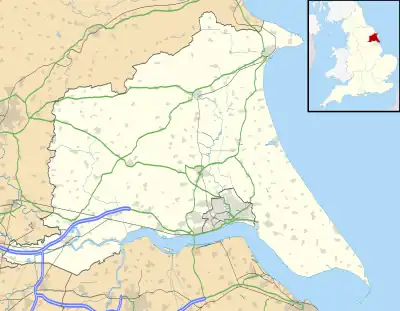Colden Parva
Colden Parva (also known as Little Cowden) is a former village and ecclesiastical parish of the East Riding of Yorkshire that was lost due to coastal erosion in the 18th century. The name persisted as part of the ecclesiastical parish covering nearby Aldbrough until into the 1970s.
| Colden Parva (Little Cowden) | |
|---|---|
| Ecclesiastical parish | |
 Colden Parva (Little Cowden) Location within the East Riding of Yorkshire | |
| Shire county | |
| Region | |
| Country | England |
| Sovereign state | United Kingdom |
History
The village of Little Cowden is recorded in the Domesday Book as being one of the smallest populated places in the Domesday record.[1] The village of Little Cowden is listed as having seven houses in 1401, and was being occupied until 1517, when it was largely deserted.[2] Church records show that 24 persons were evicted on the orders of St Mary's Abbey in York.[3] Although some farmsteads continued in the area, most of the land in the parish and village had been lost to coastal erosion.[4] The village is recorded as being "swept away by the sea" in 1690, but the church had been lost as early as 1627.[5][6] The area became the property of the Ros family, then the le Despenser family, and finally the Wentworths.[7]
Little Cowden/Colden Parva was listed as a village as it had a church dedicated to St John the Evangelist.[8] The presence of the church and the link in religious terms to the ecclesiastical parish of Aldbrough, meant that the name of the village was still listed in the 1970s. The York Diocesan Yearbook for 1975 has an entry for "Aldbrough, St Bartholomew, with Colden Parva, St John the Evangelist (now in the sea)."[9] As a few acres of the parish still existed on dry land, churchwardens were still being elected to the defunct church in the 1970s due to an act dating back to the 13th century.[5]
Parts of the old parish were still extant in the 19th and 20th centuries, with the ecclesiastical parish covering an area of 728 acres (295 ha) in 1852, however, the loss rate of land due to coastal erosion was listed as being 3.8 yards (3.5 m) a year.[10][11] What remained of Colden Parva in 1892 was two farms under its other name of Little Cowden.[12] The western area of what remained of the parish became part of the Cowden military range, but this was closed in the early 21st century, and most of what was left of Colden Parva/Little Cowden had been washed away by 2009.[13]
See also
References
- "[Little] Cowden | Domesday Book". opendomesday.org. Retrieved 30 August 2023.
- Fletcher 2002, p. 310.
- Beresford, Maurice Warwick (1963) [1954]. The lost villages of England. London: Lutterworth Press. p. 304. OCLC 1194441244.
- "Little Cowden". heritagegateway.org.uk. Retrieved 30 August 2023.
- Russel, Stuart (31 July 1975). "Owthorne and the final tragedy, and the last days of Colden Parva". Hull Daily Mail. No. 27, 909. p. 8. ISSN 1741-3419.
- Sheppard, Thomas (1912). The Lost Towns of the Yorkshire Coast. Hull: Brown & Sons. p. 162. OCLC 613711266.
- Fletcher 2002, p. 312.
- Whellan, T. (1856). History and topography of the City of York and the Ainsty wapentake and the East Riding of Yorkshire. Beverley: Sheahan & Whellan. p. 425. OCLC 23461588.
- "Wardens of a church which doesn't exist". Hull Daily Mail. No. 27, 822. 21 April 1975. p. 6. ISSN 1741-3419.
- Fletcher 2002, p. 306.
- Reid, Clement (1885). The Geology of Holderness, and the Adjoining Parts of Yorkshire and Lincolnshire. London: HMSO. p. 96.
- "Genuki: Mappleton Parish information from Bulmers' 1892., Yorkshire (East Riding)". genuki.org.uk. Retrieved 30 August 2023.
- "Rapid coastal zone assessment survey; Bempton to Donna Nook phase 2 part 2". historicengland.org.uk. p. 105. Retrieved 1 September 2023.
Sources
- Fletcher, A. J., ed. (2002). A history of the county of York, East Riding. 7: Holderness Wapentake: Middle and North divisions. Oxford: Oxford University Press. ISBN 0-19-722797-X.